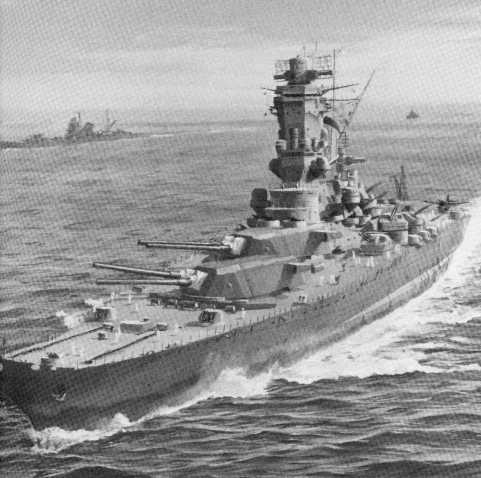An artist’s interpretation of a Design A-150 battleship by Richard Allison.
Design A-150, also known as the Super Yamato class,[A 1] was a Japanese plan for a class of battleships. Begun in 1938–39, the design was mostly complete by 1941. However, so that a demand for other types of warships could be met, all work on Design A-150 was halted and no keels were laid. Authors William H. Garzke and Robert O. Dulin have argued that Design A-150 would have been the “most powerful battleships in history” because of the massive size of their main battery of six 510 mm (20 in) guns as well as numerous smaller caliber weapons.
Initial plans for the A-150 battleships called for eight or nine 510 mm (20.1 in) guns in quadruple or triple turrets. The successful construction of a 480 mm (18.9 in) gun in 1920–1921 made the Japanese confident that a 510 mm (20.1 in) could be built. In addition, a top speed of 30 kn (35 mph; 56 km/h) was desired so that the class would be faster than the United States’ 27 kn (31 mph; 50 km/h) North Carolina-class battleships. However, these grand specifications were curtailed when tests culminated in a ship that had a displacement of some 90,000 tons; it was felt that ships of this size would be “too large and too expensive”.
Initial design studies were undertaken after the completion of plans for the Yamato class (1938–39); they focused on a ship with a displacement nearer to that of the Yamato’s. As the Japanese expected that the Americans would be able to obtain the true characteristics of that class (namely the principal armament of 460 mm (18.1 in)), the use of 510 mm guns was vital to keep with Japan’s policy of individual ships’ superiority over their American counterparts; the A-150s were meant to counter the United States’ reply to the Yamatos.
Plans were “essentially completed” sometime in 1941; however, similar to the fate of documents relating to the Yamato class, most papers and all plans relating to the class were destroyed at the end of the war, meaning that the full specifications of the ships are not known. It is known the ships would have had much greater firepower than the Yamato class—a main battery of six 510 mm (20.1 inch) guns in three twin turrets and a secondary armament of “many” 100 mm (3.9 in)/65 caliber guns. The displacement was to be similar to the Yamato class, which was around 60,000–70,000 tonnes. The side armor belt was probably going to be 460 mm (18 in). This was so large that steel mills in Japan were incapable of manufacturing it; instead, “double strakes of armor plates” were going to be utilized, which would have been much less effective than just one single plate.
Although details of the smaller armament planned for the ships are not given in sources, a main battery of six 510 mm (20.1 in)/45 caliber guns in dual turrets was definitely planned. These would have been the largest ever fitted to a capital ship, dwarfing the 460 mm (18.1 in) guns mounted on the Yamato class. By 1941, one—possibly two—of the 510 mm guns were being constructed at the Kure Naval Arsenal and detailed designs of the turrets that would hold the guns were drawn up. The turrets would have weighed 2,780 tonnes (2,740 long tons) and trained at 2° per second through a range of 120° to port or starboard. The guns themselves could have fired at a maximum rate of 1 to 1.5 rounds per minute and be elevated from -5° to 45°, with the elevation rate being 10° per second. They would have weighed 227 t (223 long tons) and would have been 23.56 m (928 in) long. The bore length was to have been around 22.84 m (899 in). The armor-piercing ammunition would have weighed between 1900 and 2000 kg (4190–4409 lbs), while the high explosive rounds would have been 1,858 kg (4,100 lb).
A secondary battery of “many” 100 mm (3.9 in)/65 caliber guns was being considered, although this was not final. This design was the best anti-aircraft gun produced by Japan during the Second World War. Overall, the weapons compared very well with other contemporary weapons. The key advantages that made it so successful—the “high muzzle velocity and a fast rate of fire”—resulted in a short 350–400-round service life. In anti-aircraft defense, their ceiling at 90° was 13,000 m (43,000 ft), although the effective range was 11,000 m (36,000 ft). They were able to fire 15–21 rounds per minute.
In Battleships: Axis and Neutral Battleships in World War II, authors William H. Garzke and Robert O. Dulin argued that Design A-150 would have been the “most powerful battleships in history” because of the titanic main armament and the use of a dual purpose secondary battery.
With war on the horizon in early 1941, all design work was diverted from battleships—even though the A-150s’ design was virtually complete—so that a demand for “aircraft carriers, cruisers, and smaller ships” could be met. Even though no work was being done on them, two ships of Design A-150, provisionally designated as Warships Number 798 and 799, were projected in a 1942 building program. 798 was to be built in the same dock as Shinano, while 799 was to be built in Kure in the same dock as Yamato after the fourth ship in the class, Warship Number 111, was launched. Both of the ships’ keels were supposed to be laid in late 1941 or early 1942, launched in 1944/45, and finished in 1946/47. However, the war’s turn against the Japanese after the Battle of Midway meant that the need for ships other than battleships never abated.
